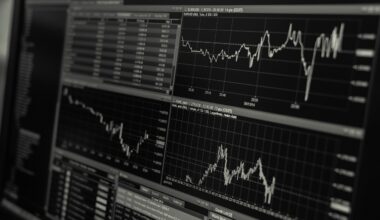The History and Origin of Candlestick Charts in Finance
Candlestick charts have a rich history that traces back to ancient Japan, where they were utilized in the rice trade as early as the 17th century. The technique was developed by Munehisa Homma, a rice trader from Sakata, who recognized the value of visualizing price movements over time. His methods were based on the psychological aspects of trading, encompassing both market supply and demand. Over time, Homma’s approach gained recognition, leading to the development of what we now call candlestick charts. These charts encapsulate essential information about price movements, including opening, closing, high, and low prices, all in a single visual format. The use of colors in candlestick charts, such as green for bullish movements and red for bearish movements, was standardized in the modern era. The adoption of candlestick charts in financial markets was largely due to their ability to give traders insight into market sentiment. As traders increasingly recognized their predictive potential, candlestick patterns became instrumental in technical analysis, helping to identify potential reversals and continuations in market trends. This innovation transformed the landscape of trading and investing, influencing how individuals and institutions approach market analysis.
With the advent of technology and the internet, candlestick charts gained widespread popularity amongst traders globally. The 1980s saw a surge in the accessibility of technical analysis tools, which included the digitization of candlestick patterns. This change made it simpler for traders to analyze and interpret price movements using specialized software. They also found application beyond rice trading, spanning various financial markets including stocks, forex, and commodities. Online trading platforms began to incorporate candlestick charts as fundamental features, enabling traders to view real-time data and enhance their decision-making processes. Furthermore, various educational resources, including books, courses, and online lectures, emerged, focusing specifically on candlestick patterns. Notably, Steve Nison is credited with popularizing these charts in the Western world through his seminal books. His work laid the foundation for a new wave of traders to embrace candlestick analysis, leading to a more informed and strategic approach toward trading. Thus, traders began to appreciate not only the historical context of these charts but also their enduring relevance in modern financial markets. As this trend continued, the significance of candlestick patterns in price analysis solidified their position within technical trading methodologies.
Candlesticks provide comprehensive insights into market dynamics, with specific patterns that traders learn to identify and interpret. Some common patterns include dojis, hammers, and engulfing patterns, each signifying distinct market conditions. A doji, for example, represents market indecision, while a hammer indicates potential bullish reversals. These recognizable formations contribute to traders’ ability to make informed decisions based on visual analysis. The emotional aspect of trading plays a crucial role here, as patterns reflect collective trader psychology. Candlestick patterns can serve as early indicators of impending market shifts or trend confirmations. Moreover, integrating candlestick analysis with other technical indicators can enhance its effectiveness. For instance, combining candlestick patterns with moving averages can yield greater contextual awareness, allowing traders to make more confident decisions. As traders become more adept at interpreting multiple tools, their market analysis improves. Advanced traders often employ a blend of candlestick strategies alongside fundamental analysis to achieve a robust trading strategy. Hence, the evolution of candlestick charts illustrates their adaptability within an evolving financial landscape, making them indispensable for traders seeking to interpret market movements and predictive behavior.
The Global Influence of Candlestick Charts
Globally, the relevance of candlestick charts in trading transcends cultural boundaries, attracting a diverse audience interested in finance. The ease of understanding candlestick patterns makes them appealing to both novice and experienced traders. This widespread adoption indicates a universal need for efficient decision-making tools in various market environments. Moreover, online forums and communities have sprung up around candlestick analysis, fostering collaboration and knowledge-sharing among traders worldwide. Through these platforms, traders can exchange insights, experiences, and strategies related to candlestick patterns, thereby enhancing their collective understanding. Additionally, social media platforms have amplified the reach of candlestick education, with influencers and educators promoting their techniques through engaging content. Consequently, video tutorials, webinars, and interactive online courses focusing on candlestick trading have proliferated. This democratization of information has empowered individuals to delve into the complexities of finance without requiring formal assistance. The transition toward e-learning within trading education emphasizes how candlestick charts have become foundational tools in modern finance. Overall, the global influence of candlestick charts continues to grow, mirroring the broader trends within the trading community.
Continuing to evolve, candlestick charts have also paved the way for algorithmic trading and automated systems. As machine learning and AI have gained traction in finance, integrating candlestick patterns into algorithms has become commonplace. Traders are increasingly leveraging advanced analytics to identify and act on specific candlestick formations. This technological advancement allows for executing trades at speeds and efficiencies unattainable through manual methods. Moreover, quantitative analysis has enriched the understanding of candlestick patterns, providing empirical data to assess their predictive accuracy. Traders can now backtest various strategies involving candlestick patterns, optimizing performance based on historical data. Moreover, algorithm-driven trading platforms often emphasize risk management by incorporating stop-loss and take-profit levels aligned with candlestick signals. As nanosecond trading becomes prevalent, understanding the nuances of candlestick patterns becomes necessary for professionals aiming to remain competitive. Consequently, the relationship between candlestick patterns and algorithmic trading continues to thrive, demonstrating the versatility of these charts in an increasingly fast-paced financial environment. This marriage of traditional techniques with modern technology exemplifies how candlestick charts have adapted to ongoing changes in financial trading practices.
Conclusion: The Enduring Legacy of Candlestick Patterns
In conclusion, the historic significance of candlestick charts persists in contemporary finance, marking their evolution and adaptability through centuries. As a beautifully complex financial tool, candlestick patterns encapsulate market sentiment, allowing traders to make informed decisions. Their rich origins and the developments over time illustrate how these charts have flourished in popularity. Additionally, the ongoing advancements in technology and trading systems have further entrenched the role of candlestick charts in financial analysis. The accessibility of educational resources has democratized knowledge, making candlestick analysis widely available and relevant. With advancements in automation, algorithmic trading incorporates candlestick patterns seamlessly into sophisticated trading strategies. Ultimately, the compelling story of candlestick charts highlights their continuance as essential components in the art of technical analysis. The commitment of traders to mastering these techniques ensures their enduring legacy in finance, despite an ever-changing market landscape. As new generations of traders explore these patterns, candlestick charts will undoubtedly remain a cornerstone of analytical prowess. Their historical resonance and future potential provide valuable resources for navigating the complexities of today’s financial markets.
In summary, the historical journey of candlestick patterns has left an indelible mark on the financial sector. They serve as powerful tools for traders seeking to understand and interpret market trends visually. From their origins in Japan’s rice market to their contemporary application across diverse financial landscapes, candlestick charts epitomize the intersection of psychology and market analysis. As traders across the globe continue to embrace these tools, the future of candlestick charts appears bright and brimming with opportunities. The investment in learning these patterns translates into tangible results, allowing traders to navigate complex market scenarios effectively. Moreover, the fusion of candlestick analysis with modern technology has redefined trading strategies, establishing a rich context for better understanding price movements. Through these developments, candlestick charts have successfully maintained relevance, making them a staple in trading due to their rich informational value. Thus, newcomers and veterans alike will find substantial value in harnessing the insights offered by candlestick charts. As time progresses, it is clear that the study of candlestick patterns will continue to evolve, growing in significance in the unpredictable world of finance.
With ongoing research on trading patterns and advancements in analytical techniques, the perception of candlestick patterns faces continual refinement. Scholars and traders alike analyze historical data to unravel the psychological elements fueling price movements. As finance becomes increasingly intricate, incorporating candlestick analysis within broader frameworks continues to evolve. Upcoming years will likely herald further innovations in visual data representation, further enhancing trader understanding. This evolution of candlestick patterns signifies a shift towards integrating behavioral economics and data analytics through technological advancements. Thus, the future of candlestick analysis promises to be both exciting and transformative, challenging traditional paradigms in trading. Consequently, the blend of historical knowledge and modern analytical approaches facilitates a profound understanding of trading behaviors and market trends. Therefore, the dialogue surrounding candlestick patterns will persist, encouraging discourse on best practices among traders. Ultimately, the ongoing development and examination of these techniques will foster continuous improvement within the trading community. Candlestick charts, with their rich heritage and promising future, are poised to play a pivotal role in the ever-evolving landscape of finance.


